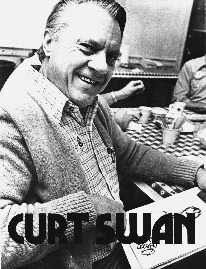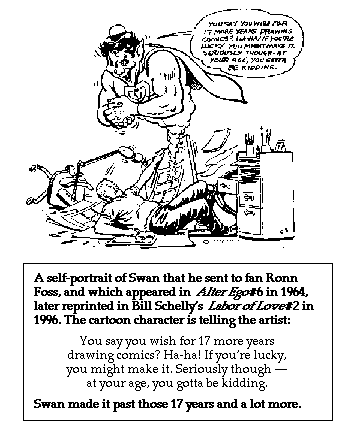The following is a slightly edited version of an essay that appeared as part of Harry Broertjes' contribution to the August 1996 mailing of Interlac, the Legion of Super-Heroes/comics/pop culture apa.
CURT SWAN, 1920-1996

By HARRY BROERTJES
Curt Swan was The Man.
Like Norman Rockwell, who was reputed to be one of the greatest influences on his work, he tended to be appreciated and yet taken for granted by the part of the world that was his audience. He was solid, dependable and professional, not flashy, flighty and self-indulgent. Swan defined Superman as much as Rockwell defined the Middle America of a generation or two ago -- and if neither of those men had come along, our perceptions both of the Man of Steel and of the world many of us grew up in would be substantially different.
And both artists are viewed, at best, with benign tolerance by many of the self-anointed opinion leaders of their respective art worlds.
Well, I don't want to stretch the Norman Rockwell comparison too far, but my point is this: The legacy Curt Swan left after his death in June at age 76 is far deeper and far more significant than some people are willing to acknowledge.
To be blunt about it, Swan was probably more of a craftsman than an artist. "Art" connotes quirkiness, angst and deliberate departures from the expectations and tastes of the hoi polloi. "Craft," on the other hand, connotes a diligent attention to detail that not only takes into account the expectations of the audience, but in fact caters to those expectations. "Art" says, "Let me please myself -- and if you like it, fine, but your approval isn't that important"; "craft" says, "Let me please you, and if I can throw in a personal touch here and there, fine, but my ego isn't that important."
And indeed, Swan's work brought me all sorts of quiet pleasure over the years. When I started reading comics seriously around age 10 in the mid-1960s, he was the first artist whose style I could recognize on sight. (He was also the only artist who, in my young opinion, drew Superman's S-symbol correctly . . . although Kurt Schaffenberger came close. That's an opinion that I never, ever changed.) The Superman stories he drew seemed, somehow, more genuine than those drawn by the other principal Superman artist of the time, Al Plastino, and more fluid than those drawn by John Forte, whose pencil work appeared, mainly, in Jimmy Olsen and on the Legion of Super-Heroes in Adventure Comics. (For a while in earlier years, Forte inked Swan's pencils, something I had no clue of at the time.) All I knew at the time was, I wished Curt Swan could draw every issue of all seven Superman family titles, instead of just the covers of all of them except Lois Lane, which was Schaffenberger's undisputed territory.
Then, in the fall of 1965, my subscription copy of Adventure Comics #340 arrived in the mail, and I thought, "Yesssss!!" Curt Swan had drawn a Legion story! (I didn't know at the time that he had drawn the Legion vs. Devil Girl story a few years earlier.) His seeming debut was incredibly important to me because the man I considered the best comic-book artist ever was replacing Forte, someone whose work I didn't really care for, on a series I liked a lot. If, the day before Adventure #340 arrived, you had asked me to name my favorite comic, it probably would have been Superboy. Instantly, when I saw Swan on the Legion, that changed. The Legion was it. When Jim Shooter's stories started to appear six months later, my feelings were cast in inertron.
Fast-forward a few years now. The Legion lost Adventure and its backup slot in Action Comics, but Swan was still hard at work. Julie Schwartz and Murray Boltinoff had taken over Superman and Action, and Swan was drawing both, inked by Murphy Anderson. With the departure of Superman family editor Mort Weisinger, the tone and substance of the titles had changed, but Swan adapted easily. What I found distressing, though, was that Swan was no longer doing the covers. There was Neal Adams on that assignment instead, and later on Nick Cardy, and it seemed to be a real shame. By that point, I was aware of some of the behind-the-scenes events at DC -- including the elevation of Carmine Infantino to publisher -- and so I had some idea why Swan's work was no longer there for everyone to see immediately on the newsstands. His covers were thought to be too static, too sedate, to sell a lot of comics in the '70s.
 And
who knows, maybe that was so. For well over a decade, Swan drew situations
on the Superman family covers: Brainiac and Luthor gloating as a shrunken
Superman stood helplessly in a cage; Superman presiding over the marriage
of Jimmy Olsen to a gorilla; four new Legionnaires standing at attention
before the rest of the group in LSH headquarters; countless reprint annuals
with postage-stamp teases to each story inside. There was very little action
in the covers Weisinger gave him to draw.
And
who knows, maybe that was so. For well over a decade, Swan drew situations
on the Superman family covers: Brainiac and Luthor gloating as a shrunken
Superman stood helplessly in a cage; Superman presiding over the marriage
of Jimmy Olsen to a gorilla; four new Legionnaires standing at attention
before the rest of the group in LSH headquarters; countless reprint annuals
with postage-stamp teases to each story inside. There was very little action
in the covers Weisinger gave him to draw.
But dynamic action, dynamic emotion and dynamic excitement became the key words a quarter-century ago. Maybe Swan wasn't the best artist for that sort of thing. But I still wondered whether Adams' grotesquely sinewy figures or Cardy's cartoony renderings led to any improvement in sales. Then and now, I suspected not.
So Swan's work remained behind the covers, as beautiful as ever (except when he was inked by Frank Chiaramonte or Vince Colletta).
In the early days of The Legion Outpost, when the Legion series was a half-step away from limbo, I wasn't alone in wishing Shooter and Swan would come back and return it to glory. Shooter did return, for a short while, but Swan made only very infrequent guest appearances. Many people over the years told me that Swan hated doing the Legion -- too many characters, too much to keep track of.
I never heard that from the man's mouth; he's one of the few favorites of mine whose path I never managed to cross. He attended conventions -- usually small ones -- only on rare occasions, and from what I heard, his visits to the DC offices were almost as infrequent. Apparently he was content to work at home in Connecticut, collect his paychecks and let the world of comics take care of itself.
But he didn't hold his fans in contempt the way some prima donnas do. If a fan asked him nicely for a favor, he was glad to oblige. He drew the cover for Interlac's 25th mailing. He drew the birth announcement for Sarah Pachter, the daughter of my friend Richard Pachter. Other fans have had similar experiences.
My one contact with Swan occurred in the mid-'70s. Somehow, I'd gotten hold of his home address, and I got the idea of asking him to draw a cover for the Outpost. So, presumptuous sort that I was -- and probably still am -- I wrote him a letter describing what I had in mind, enclosed a copy or two of Adventure for reference, and wrote him a check for, as I recall, thirty dollars. Off in the mail it all went. A week later -- a week! -- I received a mailing tube containing just what I'd asked for, only 10 times more beautiful than I'd imagined it might be. ( This piece appeared as the cover of The Legion Outpost #9.)
I had no idea what might have gone through Swan's head when he received my big envelope. It might have been, "Goddamn fan *mumble, grumble*. Maybe if I do this he'll be happy and leave me alone." But I suspect it was more along the lines of, "Kids do the darnedest things. I'll do something nice for him while I'm watching TV and hope he likes it."
The thing is, I had no idea what his page rate was at the time. I just made a semi-educated guess when I wrote that check. He probably went to his grave with my owing him another $20 or $30.
If he had the time, especially after he retired from full-time penciling for DC, he seemed to be happy to draw just about anything. His work showed up in one of Marvel's who's who-type volumes. He even drew one of the strangest Swamp Thing stories of all time just within the past year, a parody of right-wing political beliefs that had Chester the dope-smoking hippie giving up his old life to become a cop. Yes, it was an imaginary story.
So, allegedly, was Curt's swan song on Superman. It wasn't the final Superman story that he drew -- he came back and did several after the John Byrne relaunch of 1986 -- but for all intents and purposes he drew the curtain on the Earth-1 Superman, telling with Alan Moore, George Perez and Kurt Schaffenberger the final adventure and retirement of the character that he, more than any individual, defined.
The story appeared in two parts, beginning in Superman #423 and concluding in Action #583. Swan might have rolled his eyes when he read the script; virtually every major supporting character and villain, from the Kryptonite Kid to the Legion, had a part in the story. Even Kara Zor-El was there in this post-Crisis story before the ironclad rule (broken only once since then) was laid down that her existence never, ever be acknowledged in four colors again. But Swan's work on the story was typically masterly from start to finish, including the covers, where his work hadn't appeared for a decade. If nothing else, DC knew how to send off the Earth-1 Superman with class, and knew it would be impossible to do it effectively without Swan at the drawing board. That was how closely Swan was identified with the Superman family.
A lot of fans, no doubt, shrugged and went on with their lives when they heard that Swan had died. (One of them may have been the oblivious person who added the last-minute tribute to "Kirk Swan" to the San Diego Comic Con program book immediately after his death.) No big loss beyond the routine tragedy of death, they probably figured. But for me, Swan was an irreplaceable titan in comics.
At least I've got a couple of thousand comics bearing his work to remind me that Curt Swan was, is, and always will be The Man.
Many thanks to:
Paul Levitz of DC Comics for providing the photo of Swan.
Bill Schelly for making Swan's cartoon available. Ronn Foss has had the cartoon on the market for a while, and is entertaining offers for it; he can be reached at: Rte. 3, Box 40, Birch Tree, Missouri 65438. Bill's Labors of Love #2, a compendium of classic examples from the ditto age of fanzines, is available for $7.95 plus $2 for postage from Bill at P.O. Box 27471, Seattle, Washington 98125.
Updated 10.29.96